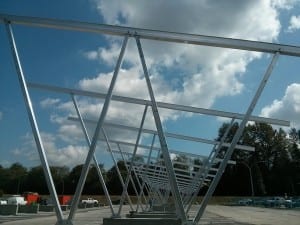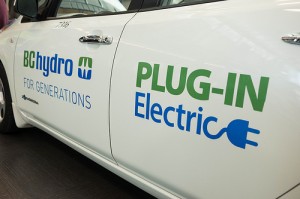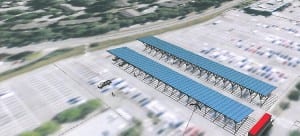UPDATE: The structure is up!
 BCIT’s SMART applied research group has been working diligently over the past few months on the Energy OASIS project. A component of the Smart MicroGrid Program, the Energy OASIS project broke ground on May 1, 2013, in Lot 7 of BCIT’s Burnaby Campus.
BCIT’s SMART applied research group has been working diligently over the past few months on the Energy OASIS project. A component of the Smart MicroGrid Program, the Energy OASIS project broke ground on May 1, 2013, in Lot 7 of BCIT’s Burnaby Campus.
Construction is well under way. The solar panel support structure is in place. The work of installing and connecting the PV (solar) panels is about to start. The expected completion date of the construction work is November 1, 2013. Check it out while you are near Lot 7.
About the Energy OASIS (Open Access to Sustainable Intermittent Sources) Project
Utilities and Independent Power Producers (IPPs) are moving toward cleaner sources of power, such as wind and solar energy. The problem: These sources of energy are intermittent, troublesome in a world with increasing and variable energy demands.
A potential solution to this problem is the use of energy storage (something like a battery) with wind and solar energy to deliver energy on-demand.
 Energy storage systems offer the additional advantage of providing reliable back-up power in the event of a grid system outage, and they can provide a clean energy source for electric vehicles further reducing reliance on fossil fuels. Electric vehicle quick charging can be challenging for utilities, and the electricity grid, given the instantaneous high demands associated with use of these technologies. The Energy Oasis project is designed to investigate this challenge.
Energy storage systems offer the additional advantage of providing reliable back-up power in the event of a grid system outage, and they can provide a clean energy source for electric vehicles further reducing reliance on fossil fuels. Electric vehicle quick charging can be challenging for utilities, and the electricity grid, given the instantaneous high demands associated with use of these technologies. The Energy Oasis project is designed to investigate this challenge.
BCIT’s SMART applied research group is tasked with coming up with innovative solutions, theories and technologies before they are implemented in the real-world power grid. BCIT’s Smart MicroGrid, the only one of its kind in North America, provides the perfect testing ground for this research and has become an international attraction with missions from Mexico, Chile, Brazil, Vietnam and across North America.
The research being conducted at BCIT is a key part of the NSERC Smart Microgrid Network, a research partnership of Canadian universities, government and industry.
In future, Smart Microgrids will enable energy conservation, increased operational efficiencies and a more resilient mix of energy sources.
More Information
Questions about the Energy OASIS project?
Please visit: bcit.ca/microgrid/energyoasis/.

Hello there,
Kudos to have the OASIS project up and running sucessfully for quite a years now. As you know, electric cars have become very popular. However, one of the problems I am finding is the lack of accessibility of charging stations. While most people can charge at home, we also spend alot of time at work/school. As an employee of BCIT, I find it frustrating with such few charging stations for EVs.
Please consider installing more EV stations on our campus. There is no better way to educate the masses on the benefits of electric vehicles than to show everyone our believe in Open Access to Sustainbale Intermittent Sources (OASIS). BCIT believes in a more environmentally sustainable transportation and we hope BCIT can stand by this initiative by embracing newer technologies for the benefit of future generations. It is important for BCIT to encourage a cleaner commute to reduce carbon emissions from their employees and students.
BCIT has paved the way in researching energy and EV charging stations. Let’s continue to be education leaders in environmentally friendly practices, campus wide green initiatives that include the design and implementation of EV charging stations.
Thank you for your consideration with installing more electric charging stations at the BCIT Burnaby Campus.
Hello Joanne,
thanks so much for your kind feedback about the EV chargers at OASIS. We generally get complaints so your email was a nice change. It is also nice to hear that you charge at home, and elsewhere just as needed rather than aiming to always “keep your tank full”. Sounds like you follow a great changing process.
The OASIS Solar Microgrid Facility, and the EV chargers it powers, were all installed and are managed and maintained by the Smart Microgrid Applied Research Team (SMART Lab) at CARI through our industry and grant funded research projects. The chargers at OASIS aren’t funded by BCIT per say. Their primary purpose and obligation is to our research. And while not always visible, our EV infrastructure research activities are always ongoing.
Most of the time the chargers are still available. Sometimes the nature of the research activity means they won’t work the way typical commercial chargers do, and sometimes we do need to take them offline. Sometimes they get damaged by misuse and we may need to wait for funding or specialized parts to fix them. Research infrastructure is tied to specific research problems, programs and funding. Extending charging infrastructure is complicated, and the decision of whether or not to install new chargers is not up to the SMART Lab.
The SMART Lab